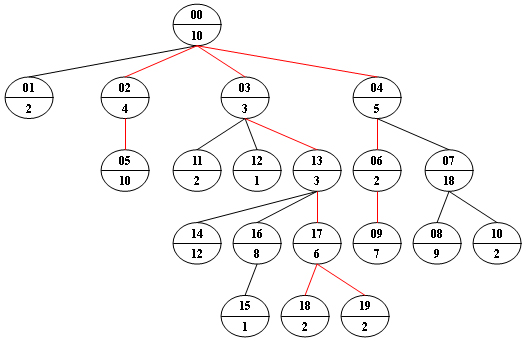【PAT】1053 Path of Equal Weight(30 分)
1053 Path of Equal Weight(30 分)
Given a non-empty tree with root R, and with weight Wi assigned to each tree node Ti. The weight of a path from R to L is defined to be the sum of the weights of all the nodes along the path from R to any leaf node L.
Now given any weighted tree, you are supposed to find all the paths with their weights equal to a given number. For example, let's consider the tree showed in the following figure: for each node, the upper number is the node ID which is a two-digit number, and the lower number is the weight of that node. Suppose that the given number is 24, then there exists 4 different paths which have the same given weight: {10 5 2 7}, {10 4 10}, {10 3 3 6 2} and {10 3 3 6 2}, which correspond to the red edges in the figure.
Input Specification:
Each input file contains one test case. Each case starts with a line containing 0<N≤100, the number of nodes in a tree, M (<N), the number of non-leaf nodes, and 0<S<230, the given weight number. The next line contains N positive numbers where Wi (<1000) corresponds to the tree node Ti. Then M lines follow, each in the format:
ID K ID[1] ID[2] ... ID[K]
where ID is a two-digit number representing a given non-leaf node, K is the number of its children, followed by a sequence of two-digit ID's of its children. For the sake of simplicity, let us fix the root ID to be 00.
Output Specification:
For each test case, print all the paths with weight S in non-increasing order. Each path occupies a line with printed weights from the root to the leaf in order. All the numbers must be separated by a space with no extra space at the end of the line.
Note: sequence {A1,A2,⋯,An} is said to be greater than sequence {B1,B2,⋯,Bm} if there exists 1≤k<min{n,m} such that Ai=Bi for i=1,⋯,k, and Ak+1>Bk+1.
Sample Input:
20 9 24
10 2 4 3 5 10 2 18 9 7 2 2 1 3 12 1 8 6 2 2
00 4 01 02 03 04
02 1 05
04 2 06 07
03 3 11 12 13
06 1 09
07 2 08 10
16 1 15
13 3 14 16 17
17 2 18 19
Sample Output:
10 5 2 7
10 4 10
10 3 3 6 2
10 3 3 6 2C++代码如下:
1 #include<iostream> 2 #include<vector> 3 #include<algorithm> 4 using namespace std; 5 #define maxn 105 6 7 struct Node { 8 int weight; 9 vector<int>child; 10 }; 11 12 int n, m, s; 13 Node num[maxn]; 14 15 bool cmp(int a, int b) { 16 return num[a].weight > num[b].weight; 17 } 18 19 vector<int>v; //存放路径对应的权值 20 void path(int r,int sum) { 21 if (sum > s) { 22 v.pop_back(); return; 23 } 24 if (sum == s) { 25 if ( num[r].child.size() == 0) { 26 cout << v[0]; 27 for (vector<int>::iterator it = v.begin() + 1; it != v.end(); it++) 28 cout << ' ' << *it; 29 cout << endl; 30 v.pop_back(); 31 return; 32 } 33 else { 34 v.pop_back(); return; 35 } 36 } 37 for (int i = 0; i < num[r].child.size(); i++) { 38 int t = num[r].child[i]; 39 v.push_back(num[t].weight); 40 path(t, sum + num[t].weight); 41 } 42 if (!v.empty()) v.pop_back(); 43 } 44 int main() { 45 cin >> n >> m >> s; 46 int w; 47 48 for (int i = 0; i < n; i++) { 49 cin >> w; 50 num[i].weight = w; 51 } 52 int id,k,t; 53 for (int i = 0; i < m; i++) { 54 cin >> id>>k; 55 for (int j = 0; j < k; j++) { 56 cin >> t; 57 num[id].child.push_back(t); 58 } 59 sort(num[id].child.begin(), num[id].child.end(), cmp); 60 } 61 v.push_back(num[0].weight); 62 path(0,num[0].weight); 63 return 0; 64 }




